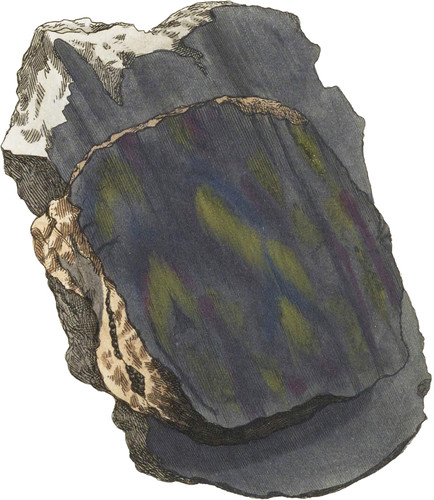 Enlarge
Enlarge
British Mineralogy
Slickensides Galæna
- Div. 2. Imitative.
- Syn.
- Spicular compact Lead Glance. Jameson 2. 355.
- Compact Galæna. Kirw. 2. 218.
- Slickensides. Bab. 170.
- Plomb sulfuré compacte. Haüy 3. 461.
This variety of Galæna, rare in any country but England, is found chiefly at Castleton in Derbyshire, and I have some specimens marked Ecton Mine, which is partly in Staffordshire. It appears to be the common Galæna, but, by a certain slip of two faces as it were of a separated mass of rock, is pressed into a finely granulated compact appearance, quite losing the regular cubic fracture, otherwise usual to Galæna, and which so essentially distinguishes it from most other substances. Sometimes this is rather massy in the interior part of the specimen, near or quite adjacent to the polished face, caused probably by the broken ends of strata slipping and pressing against each other. It may he on the face of mixed rocks, on Fluor, Quartz, and Sulphate of Barytes. It is said to be dangerous sport to the miners when they meet with it unexpectedly, as it is easily detached with a sudden explosion, and is thrown with such considerable force that it has even been fatal to those that are within its range of action; but when, as by experience, they have learnt to discover, by the sounding of their tools against the spot, that the next stroke may detach the slickensides, they stand beneath, if the situation allows, and, advising their friends to arrange themselves in safety, spring the mine as it were in triumph. I presume that the compressed air, allowed relief from a space so broad and suddenly coming into contact with the common air, causes the noise, and the expansion impels the stones to a proportionate distance, and fragments fly afar over the operator’s head, who has a reasonable cause to triumph, as his knowledge has taught him to make sport with Safety where he might have suffered by ignorance.
The specimen figured in the front of the plate is from Ecton Mine, where so many brilliant coloured and variegated specimens of Pyrites occur; and this is not a common variety, because it partakes of the splendid prismatic colours added to the highly polished surface. The piece figured behind is more usual, and at first sight very much resembles the Free-stone of a chimney when shining with common Black Lead or Plumbago, which sometimes by means of smoke has the iridescent or prismatic colours, but in this it does not resemble it, This specimen has Mineral Pitch and Pyrites about it in veins.
Other substances are liable to be polished in the same manner, and apparently from the same causes.

